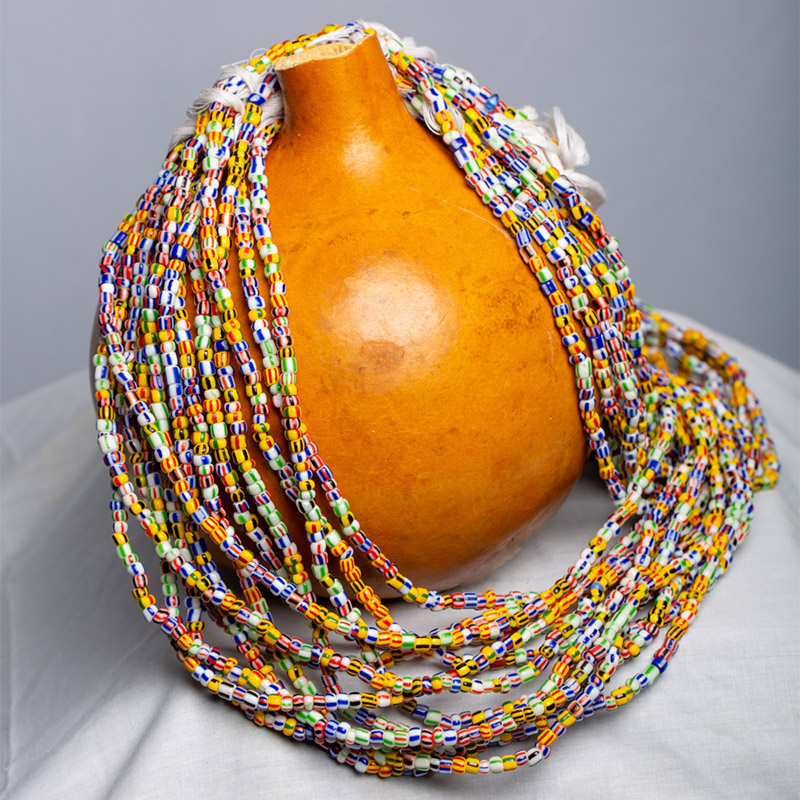The Sacred Symbolism of Beads in African Spirituality
Beads have long held deep cultural, spiritual, and symbolic meaning across the African continent. Far more than decorative adornments, beads are powerful tools used to express identity, honor ancestors, and connect with the spiritual world. In this article, we explore the multifaceted roles that beads play in African spirituality and how they continue to shape community and personal identity today.
1. Beads as a Link to Ancestry and Spirituality
Sacred Connection
In many African cultures, beads are infused with spiritual significance. They are often used in rituals, worn during ceremonies, or kept as sacred objects passed down through generations. Specific colors, shapes, or materials are believed to carry spiritual energy or messages from the ancestors.
Image Suggestion: Photo of ancestral bead necklaces or sacred bead altars (with caption: "Ancestral bead relics used in Ewe rites").
Ancestral Guidance
Beads may also serve as conduits for communicating with ancestral spirits. Worn as amulets, they are thought to invoke protection, wisdom, and blessings from those who came before.
2. Commemoration and Remembrance
Memorial Use
Beads are sometimes incorporated into memorial jewelry or artifacts to honor the deceased. Wearing these beads serves as a personal and spiritual connection to one's lineage.
Rituals and Ceremonies
During funerals, naming ceremonies, or annual ancestral festivals, beads with specific symbolism are used to reinforce the connection between the living and the dead.
Video Embed Suggestion: A short documentary clip showcasing bead use in ancestral rites (YouTube or Vimeo embed).
3. Beads as Status and Identity Symbols
Cultural Identity
In African spirituality, the type and style of beads worn can represent one's ethnic group, cultural background, or tribal affiliation. For example, among the Ewe people, particular bead patterns and colors are reserved for specific ceremonies or age groups.
Social Hierarchy
Beads are used to denote roles and social rankings. Chiefs, priestesses, or royal family members may wear elaborate beadwork to reflect their elevated spiritual or societal status.
Image Suggestion: Portraits of African royalty or spiritual leaders adorned in ceremonial beads.
4. Spiritual and Healing Significance
Protective Talismans
Beads can act as spiritual shields. In various traditions, they are believed to repel negative energy or attract blessings, depending on their color or composition.
Healing Properties
Some beads are made from materials like amber, bone, or specific stones believed to have curative powers. Healers or shamans may prescribe these beads as part of holistic treatment.
Quote Highlight:
"Wearing these beads is like carrying a prayer with you — one woven by the hands of your ancestors."
5. Artistic Expression and Storytelling
Personal Style
Beads offer a canvas for creative expression. Whether worn daily or for special events, they allow individuals to showcase personality through color, pattern, and arrangement.
Cultural Narratives
Many artisans use beads to tell stories of historical events, myths, or family lineages. Each string of beads can be a visual narrative passed down through generations.
6. Community Connection and Collective Identity
Group Belonging
In some cultures, beads are worn to signify initiation into specific communities, such as age-grade societies, religious sects, or social guilds. This fosters a strong sense of identity and belonging.
Shared Values
Beads used in festivals or group rituals serve as symbols of unity, linking individuals through shared heritage and collective memory.
7. Global Influence and Cultural Responsibility
Cross-Cultural Exchange
Today, African beadwork has found its way into global fashion, inspiring designers worldwide. While this opens doors for appreciation and collaboration, it’s essential to recognize and respect the cultural origins of these sacred symbols.
Cultural Appropriation vs. Appreciation
Wearing beads inspired by African cultures without understanding their meaning can lead to cultural appropriation. True appreciation comes from learning the history and respecting the spiritual significance behind the art.
Conclusion
From honoring ancestors to expressing identity and crafting beauty from tradition, beads are sacred threads that weave African spirituality into daily life. As they adapt to modern contexts, their power and symbolism remain rooted in the wisdom of the past.
Suggested Tags:
#AfricanSpirituality #BeadCulture #EweHeritage #AncestralWisdom #TraditionalAdornment #CulturalIdentity #LetsDiscoverAfrica
Embed Gallery Option: Carousel of traditional bead styles from various African cultures (Ashanti, Ewe, Yoruba, Zulu).





